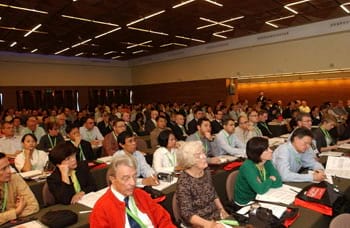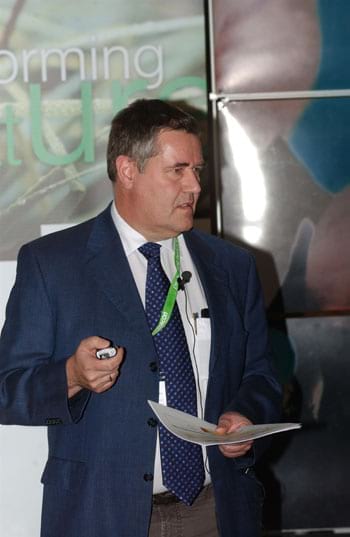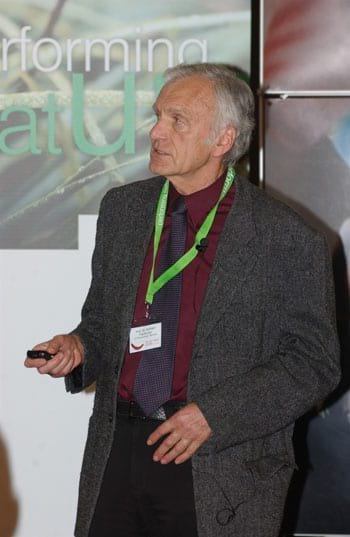The HOT SPOT in animal production and nutrition
Delacon Performing Nature Symposium in Crete/Greece
Where the Phytogenic world met in November
The Performing Nature Symposium was successfully held last week (November 4-8, 2009) on the Greece island Crete, where Delacon gathered 250 people from more than 25 countries. In these two days 18 speakers held lectures on the following topics: Trends in animal production and nutrition, Immunity and Environment.

Click here to enlarge the image
It was not only the high level of the speeches and the good organization but also the great guests making this event a success and giving it a good atmosphere.
After the official opening by Mr. Helmut Dedl (President and CEO), where he also gave a short overview on the 25 years history of the company, and a presentation on the future strategies of Delacon by Andreas Asamer (Director Marketing and Sales), Prof Dr. John Hodges presented his thoughts about boundaries in animal production. He was pointing out that there is the need for a plan B in animal production. "I think GM crops are not the silver bullet, relying on them to feed the world is too tricky," said Hodges.

The impact of this critical point of view was big and immediate, as most of the following speakers were referring to Hodges´ thoughts in their own presentations.
Trends in animal nutrition and production
Dr. Dennis DiPietre from the US was reporting on reducing variance and lowering the average final weight of slaughter hogs in order to raise profitability. According to Dr. DiPietre most of the farmers are working with averages of groups which are hiding a lot of information. Shifting the individuals back to the center of interest is a way how precision farming could come to pig production.
The program of the first day was balanced between pig and poultry topics as Mr. Neivaldo Burin from a large integrator in Brazil reported thereafter on the reasons why Brazil is one of the major poultry exporters. Brazil has enough land, water and a climate which allows up to 3 harvests a year, but he was also highlighting critical aspects as a weak infrastructure and high taxes. He also claimed that poultry meat will play an important role in order to overcome the growing demand for meat in the coming years as the feed conversion is far better in poultry than in pig and beef. With regards to Prof. Hodges’ speech he said that the industry currently is under plan A, but trying to do this most efficiently, as there is no plan B available.

Dr. Jan Dirk van der Klis from Schothorst Feed Research in the Netherlands talked about several challenges the European poultry market is facing or will face in the near future. He mentioned the EU welfare directive for broilers (effective 2010) and the EU welfare directive for layers (effective 2012). These new rules make maximum stocking density and NH3 output important criteria.
"Animal nutritionists therefore have an important role in optimizing poultry diets and improving the competitiveness of European poultry production despite these regulations," said Van der Klis. He also mentioned that since the EU ban on antimicrobial growth promoters (2006), the production of broilers and turkeys decreased due to an increase of intestinal disorders.

To overcome this, Prof Dr. Wilhelm Windisch gave an overview on alternatives to AGP´s where he mentioned organic acids, probiotics, phytogenics, enzymes, functional fibers and heavy metals as the current options. Whereby he clearly pointed out that heavy metals would work well but for their negative impact on the environment cannot be seen as practical alternatives.
Posters
The poster session on Thursday evening was dominated by results from scientific and in field trials with Delacon products from research institutes around the world.
Nutrition
On the second day of the performing nature symposium the delegates could choose between two parallel sessions. Dr. Ortwin Simon opened the session on nutrition with a speech about nutrient digestibility with phytogenics. He presented a series of metabolism trials carried out with Biostrong 510 and several other active agents. Further speeches on nutrition where than: Nutritional factors for bone problems in broiler by Prof. Dr. Colin Whitehead; Nutrient digestibility and P-retention with phytogenic feed additives by Dr. Jan Dirk van der Klis; Synergy of phytogenics with antibiotic growth promoters by Lucas Cypriano; Fresta F in weanling pigs diets setting the stage for more full-value pigs at slaughter by Dr. Ken Purser; Combination of a phytogenic with a hydrating gel for pigs by Jorge Marin; and Combination of phytogenics with Citrex – an organic antimicrobial by Dr. Douglas Zaviezo.
Immunity
The session on immunity was started by Prof. Dr. Jürgen Zentek, who gave insights in how the immune system works and how nutritional factors are influencing it. Furthermore he provided information on how phytogenic influence the immune system.
Mrs. Stefanie Gärtner presented her Ph.D.-work on the effect of Fresta F on the adhesion of pathogenic E.coli to porcine intestinal cells and on immunological parameters in piglets.
Prof. Dr. Carlos Mallmann continued with a speech entitled Clinical and immunosuppressive effects of mycotoxins and management of the problem.
Environment
Prof. Dr. Gerhard Flachowsky was highlighting that there is still a lot of work to do before an accurate calculation of the so called “Carbon footprints” can be used for regulations or restrictions. He was also pointing out that there is also a lot of “sun” in the rumen as undegradeable roughage can be transformed in high quality nutrients, and that this should never be forgotten even if there is the “shadow” of methane is making a big portion of green house gas emissions caused by them.

However emissions from livestock are already under legislative regulation. Mr. Helmut Döhler brought some light in the different EU and UN regulations focusing on air pollution or having an integrated approach like the IPPC directive (Integrated Pollution Prevention and Control).
Carlos Piñeiro was giving an input on approaches to ammonia reduction for practical use as there are feeding strategies, housing systems and manure storage processing and land spreading.
Round Tables
As there were many experts for immunity and environment on the spot, Delacon organized two round table discussions with selected participants after the sessions in order to bring them together and discuss on the status quo and future activities in these areas. One important outcome from the discussion on environment was that authorities have to set the conditions for that brand names can be registered as emission reducing techniques.
“Sympotein”
After these two tough days of the symposium with its usual meaning (academic conference), the “Greek night” on Friday was then more referring to the Greek verb sympotein which means "to drink together", whereby the participants had also the possibility to learn Greek dances, and could enjoy typical Greek food.